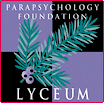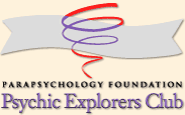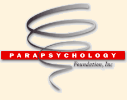 |
 |
| THE BIOGRAPHICAL DICTIONARY OF PARAPSYCHOLOGY J(OSPEH) B(ANKS) RHINE Parapsychologist; founder (with William McDougal), director, 1935 to present, of the Parapsychology Laboratory, Duke University, Durham, North Carolina. B. September 29, 1895, Juniata County, Pennsylvania; d. February 20, 1980. B.S., 1922, M.S., 1923, Ph.D., 1925, University of Chicago. M. 1920, Louisa Ella Weckesser: 3 d., 1 s. Research fellow, plant physiology, Boyce Thompson Institute, 1923-24; instructor, plant physiology, West Virginia University, 1924-26; instructor , philosophy and psychology, Duke University, 1928-29; instructor to professor, psychology, Duke University, 1929-49; director, Parapsychology Laboratory, 1935 to present. Member: Parapsychological Assn., Southern Society for Philosophy and Psychology, American Assn. for the Advancement of Science, American society for Psychical Research, Society for Psychical Research, London; Phi Beta Kappa, Phi Sigma, Sigma Xi, Phi Lambda Upsilon, Pi Gamma Mu. In 1926 Dr. Rhine went to Harvard University to investigate mediumship and worked with Dr. Walter Franklin Prince (q.v.) of the Boston Society for Psychic Research. The following year he went to Duke to study claims in the same field. Invited to stay on at Duke by Dr. William McDougall (q.v.), head of the psychology department, Dr. Rhine broadened his field of research to include other areas of parapsychology, using statistical methods to test the existence or nonexistence of telepathy, clairvoyance, precognition and psychokinesis (the influence of the mind on physical objects). In 1937, with Dr. McDougall's help and sponsorshp, Dr. Rhine founded the Journal of Parapsychology in which the experiments at Duke were reported. His systematic and repeatable methods became standard practice throughout most of the field. Dr. Rhine's effors were perhaps the greatest single contribution since the turn of the century of the study of parapsychology and its predecessor, psychic research. His work led to the founding of the first parapsychology laboratory in the world at Duke University; established at least the possibility that so-called psychic ability might be tested by methods acceptable to science generally; and stimulated experiments along similar lines in other universities and among other serious researchers all over the world. Dr. Rhine used the term "extrasensory perception" to describe the apparent perception of an external event through some means other than the known senses, and used the Greek letter psi to stand for the so-called "psychic faculty." To test extrasensory perception (ESP), he used cards, at first called Zener cards after their inventor, and later known as ESP cards (each card bears one of five symbols: star, square, cross, circle parallel wavy lines; five sets of these make up a deck). To test telepathy, a "sender" would concentrate on the symbol on a card as he turned it up; the "receiver," sometimes separated from the sender only by a screen, sometimes many miles away, would by prearranged timing concentrate on receiving the image and would record his impression. To test clairvoyance, the "receiver" would note his impressions of cards chosen face down, symbol unseen, by the sender, or would attempt to give the correct order of cards in a deck shuffled but looked at by no one until after the calling. To test psychokinesis, a subject would attempt mentally to influence the fall of dice, which were at first thrown manually and later by machine to eliminate the effects of dexterity. Statistical methods approved by authorities in mathematics were used to determine scores above chance expectations, and painstaking efforts were made to control experiments so that sensory clues would be eliminated. Over the years many subjects were found whose scores in hundreds of runs would seem to be mathematically difficult, if not impossible, to attribute to chance. Dr. Rhine and his associates also began to investigate factors that might affect extrasensory ability: personality factors in senders and receivers, belief or nonbelief in the existence of ESP, interest in or boredom with testing. In addition, biological investigations were undertaken in an effort to discover whether sex, age, pathologies or therapies would affect psi functioning; whether it is limited to the living or represents an immortal aspect of human personality; and whether psi ability exists among animals. Tesing for ESP ability and for factors affecting it continues today at Duke adn other parapsychology laboratories in the United States, Britain, the Netherlands and other countries. Recently Dr. Rhine initiated the establishment of the Foundation for Research on the Nature of Man, an organization aimed at providing support and permanent direction for the aid of research workers in parapsychology throughout the world. He has written scores of articles on parapsychology in both scholarly and popular journals, and has lectured widely before both scientific and lay audiences. He is editor of the quarterly Journal of Parapsychology published at Duke, and is author of the books Extrasensory Perception (1935); Extrasensory Perception After Sixty Years (with J. G. Pratt, Charles E. Stuart, qq.v., Burke M. Smith and Joseph A. Greenwood, q.v., 1940); The Reach of the Mind (1947); New World of the Mind (1953); Parapsychology, Frontier Science of the Mind (with J. G. Pratt; 1957). Taken from Helene Pleasants (1964) Biographical Dictionary of Parapsychology with Directory and Glossary 1946-1996 NY: Garrett Publications |
 |

|
 www. parapsychology. org |
||